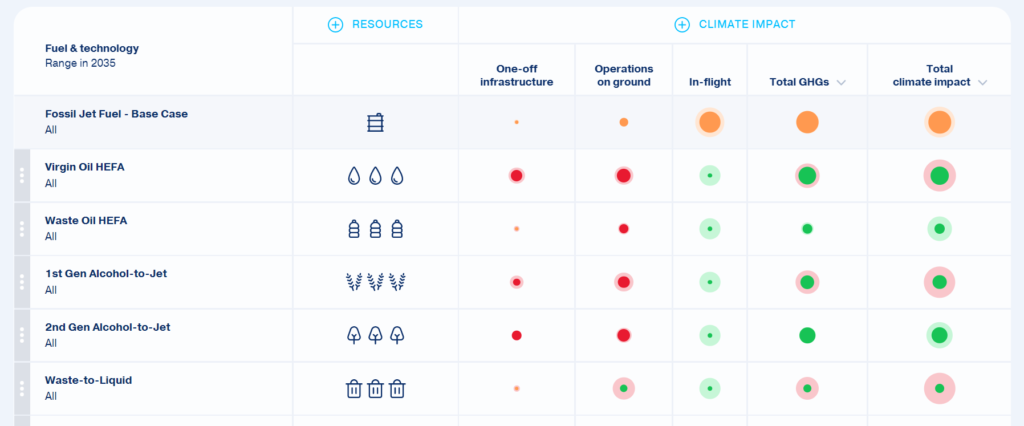This year, the AIA held a summer sixth form work experience week to introduce students who are studying STEM to our work. One student, Emma, writes about her experience at the AIA and what she learned below.
The Aviation Impact Accelerator welcomed a small team of sixth-form students interested in sustainable engineering, computer modelling and data visualisation to the Whittle Laboratory in early September 2022. This work experience provided a unique opportunity for us to pursue our learning and interests in a real-world setting. Included in this four-day forum, and in preparation for the participant’s final task, we had the chance to explore and discuss AIA’s tools: the Resource to Climate Comparison Evaluator (RECCE) (which is publicly available on the AIA website) and the Journey Impact Simulator (JIS) which is currently in development by the AIA team.

Dr Paul Hodgson guided the students’ first discussion. Using RECCE, Dr Hodgson illustrated the numerous sinks of energy within the aviation industry: one-off infrastructure which includes manufacturing aircraft, operations on the ground such as biomass processing, and in-flight CO2 and non-CO2 emissions. Jet fuel used in current operations is sourced from fossil fuels and accounts for very little one-off infrastructure and on-ground operation impacts; however, up to 206% of eq. CO2 impact is due to in-flight emissions. We compared the impacts of fossil jet fuels to those of the fourteen alternative fuel sources on RECCE.

The pictured example breaks down the sources of impact made by the processing and use of two different jet fuels. Although the total climate impact of each fuel is of the same magnitude (within 20% of each other on the upper limit), 1st Gen Alcohol-to-Jet shows a reduced efficiency in one-off infrastructure and on-ground operations compared to fossil jet fuel. Even though the in-flight emissions of 1st Gen Alcohol are minimal, the production and transportation of this fuel may contradict its benefits to the environment. Following this fascinating comparison, Dr Sam Gabra introduced the concept of balance in the student’s second discussion.
I came to understand that balance is needed to sustain the aviation industry, in terms of its environmental, financial, and social impacts. These seminars paved a path to the completion of the final tasks: discerning the sustainability of a flight using the AIA’s upcoming tool, the JIS and writing an academic report describing any problems encountered during the research done for this presentation.
One student’s report detailed a 1-hour 47 minute flight from London Heathrow Airport to Rome Fiumicino Airport, where they will be moving next summer. Their initial hypothesis describes a change in ticket cost and emissions per passenger overtime due to improvements in technology and infrastructure; estimated prices were assumed to increase from $50 in 2020 to $500 in 2050, and that CO2 emissions would decrease from 400kg to 50kg. The Journey Impact Simulator validated part of this prediction: individual ticket prices will increase monumentally as a way for commercial airlines to stay in business. However, the current estimate for CO2 emissions from fossil jet fuel was double the true value; modern flights account for only 201kg CO2e per passenger. Given current estimates, future fuel sources produce varying volumes of CO2 emission. For example, using synthesized jet fuel for this international flight would reduce CO2 emissions to 71kg/person, whereas using biomass would increase both CO2 and non-CO2 emissions exponentially.
Balance is key. Air travel is crucial to tourism, the transportation of goods, and human connection, but will be unsustainable unless in-flight and on-the-ground climate impacts are achieved.
It is critical that neither side of the industry be prioritized over the other to ensure the emission reduction in one sector is not compensated for in the other. Equally, it is unfeasible to make aviation so expensive that businesses, let alone traveling civilians, cannot afford the price of airfare or the development of these new technologies becomes redundant.
Students provided feedback on accessibility, functionality of both tools which the team will incorporate to the tools.
Both RECCE and JIS rely on the most recent data sourced from the AIA’s partners and collaborators, including but not limited to Rolls Royce, Boeing, and Etihad, to provide usable and legible information on the aviation industry.
The value I found in the experience.
My fellow students involved in this opportunity and I are eager to pursue different sectors in STEM including but not limited to artificial intelligence, astronautical engineering, and aerospace technology, found both JIS and RECCE to be intuitive and resourceful tools. Another student described the work experience to me as “an exciting and important project” that “helped us develop the skills needed to lead our own projects one day.”
This AIA work experience gave me more confidence in my capabilities in STEM. Particularly as a young woman, the opportunity to learn and receive first-hand feedback from professionals in the field is much appreciated. I feel confident with my understanding of specifics, such as the production of different jet fuels, as well as broader effects of the industry including financial accessibility.
Now more than ever, I feel equipped and welcomed to pursue engineering at university and continue to contribute to net-zero efforts.

Emma Brown
Sixth form student, Cambridge.